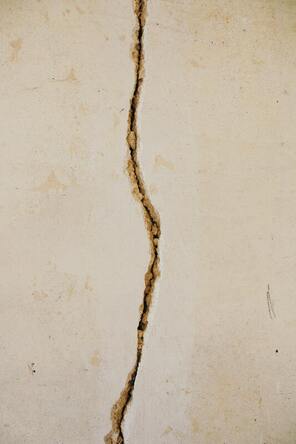"Building on ground which isn’t compacted properly will result in settlement of the structure" The ground under foundations, ground floor slabs, paving and driveways and in trenches should be compacted. Levelling an area for your house Failure to adequately compact the ground will result in the ground settling or sagging. If your house is built on ground that settles it will result in your house cracking. Cracks are unsightly, and in severe cases could result in your house collapsing. Usually an engineer will prescribe the degree of compaction and the number of layers that should be compacted. #homeconstructiontips #houseconstruction #housefoundations Obviously when compacting trenches care must be taken not to damage the pipes in the trenches as they can often be easily crushed or cracked. What you should know when excavating for your new home and to lay pipes When compacting ground it should be done in layers 100 to 150 millimetres (four to six inches) thick. Thicker layers don’t get compacted. Usually ground needs some moisture for compaction, normally referred to as the optimal moisture content. If there’s too much water, or too little, you won’t achieve the required compaction density no matter how hard it’s hit. The amount of compaction also depends on the type of machine and how many times the ground is compacted. Again there’s usually an optimum effort and too little will mean the ground isn’t compacted properly, while too much won’t make any difference to the degree of compaction after a while. Some soils, such as clean sand, can compact very easily. Topsoil and clay ground is unsuitable for using under structures. Geotechnical companies provide advice on what materials to use and undertake tests of the ground on the property and of the compacted area to check that the ground has been adequately compacted. Building on ground which isn’t compacted properly will result in settlement of the structure, paving or driveway, which will look unsightly and be costly to repair.  This is an extract from the author's book 'An Introduction to Building and Renovating Houses: Volume 1 Hiring Contractors, Managing Construction and Finishing Your Home'. © 2022 This article is not to be reproduced for commercial purposes without written permission from the author. Want to learn more about designing, renovating and building houses? Paul Netscher has written 2 easy to read books 'An Introduction to Building and Renovating Houses - Volumes 1 and 2'. An Introduction to Building and Renovating Houses Volume 1 deals with Hiring Contractors, Managing Construction and Finishing Your Home. and Designing your ideal home Volume 2 deals with Finding Your Ideal Property and Designing Your Dream Home. ("Great for those that DIY. Very helpful in home renovations!" said a Reader on Amazon.com 5*****) These books are available from Amazon and other online bookstores in paper and ebook.
0 Comments
Leave a Reply. |
AuthorI’m a construction professional, author of several successful construction management books, and a home owner. I’ve made mistakes in construction management, I’ve seen others make mistakes, but importantly I’ve had multiple successful construction projects and I’ve learned from the mistakes. I want to share these lessons and my knowledge with you. Also available from:
Amazon Au, Amazon DE, Amazon ES, Amazon CA, Amazon IT, Amazon FR, Amazon NL, Amazon India and 'An Introduction to Building Houses - Volume 2 Finding Your Ideal Property and Designing Your Dream Home'
Archives
July 2024
CategoriesWe welcome genuine comments, especially comments that add additional information to the subject matter in the article. We however reserve the right to remove inappropriate comments, which includes comments that have nothing to do with the subject, comments that include inappropriate language, and comments that are an advertisement for a product or company, or which include an advertising link. Comments must be in English. We will not enter into discussion on why a particular comment was removed.
|





 RSS Feed
RSS Feed


